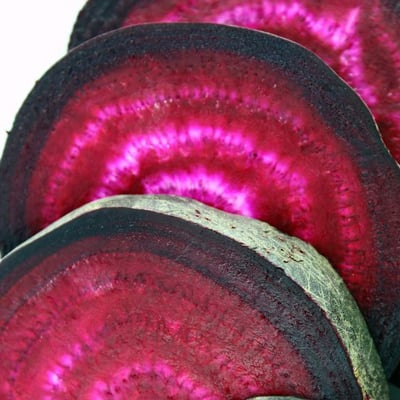 Beet juice extract (EU), or beetroot extract, (from Beta vulgar rubra) is showing up with more frequency on labels driven by the demand for naturally-sourced ingredients. Beetroot red (E162) (EU) can provide a range of red from a deep raspberry-like color with blue notes, to a bright strawberry-red color. However, using beetroot extract for coloring is not without some processing and stability challenges.
Beet juice extract (EU), or beetroot extract, (from Beta vulgar rubra) is showing up with more frequency on labels driven by the demand for naturally-sourced ingredients. Beetroot red (E162) (EU) can provide a range of red from a deep raspberry-like color with blue notes, to a bright strawberry-red color. However, using beetroot extract for coloring is not without some processing and stability challenges.
Beetroot Overview:
Beetroot extracts contain roughly 0.5-1% of an intense red pigment called betanin (EU). The extract also contains a small quantity of a yellow pigment called vulgaxanthin. Beet extract is often used at a high level within formulas compared to other food colors, but even at high formula levels the extracts don’t change product flavor. For example, beetroot extract is successfully used in ice cream (EU) formulas as high as 0.5%.
To manufacture this water-soluble coloring, the beet roots are pressed or diffused at a low pH, ultrafiltered to concentrate, and pasteurized. The juice can be spray-dried onto a carrier like maltodextrin (EU) where the final betanin percentage is about 0.3-0.5%.
Achieving Consistent Color:
Beets are a natural ingredient, so the shade can vary based on crop conditions. Specifications for beetroot often include the ratio of betanin (red) and vulgxanthin (yellow). The color of beet juice changes as the extract ages and the blue notes within the extract diminish leaving a brighter more pink color. When sourcing a beet extract for color work closely with your vendor to ensure that the color purchased is consistent between each batch over the year. As many consumers equate consistency with quality, you will need to understand the potential differences within the range of color achieved with your beetroot extract source.
Challenge – pH
Betanin provides a fairly stable color in typical food pH (EU) conditions. At a pH of 4 the expected color will be a bluish-red which will become more blue-violet as the pH increases above 5. However, as the pH becomes alkaline, above 7.5, the red family of hues is degraded by hydrolysis resulting in a yellow-brown color.
Challenge – Oxygen
In high moisture products or in liquid form, betanin degrades in the presence of oxygen. Often this can be overcome by protecting the food from oxidation by including antioxidants, sequestrates and/or using modified atmosphere packaging. As a dry product betanin is more stable, but for optimal shelf life limiting oxygen exposure is ideal.
Challenge – Light
While consumers like to see food products, putting your beetroot colored food in a clear package will result in an unstable red color over time. To keep the red color over shelf life choose packaging that protects the product from light, whether that is an opaque or dark packaging. Or, change the shelf life requirements to account for the color loss within the conditions of your distribution system.
Challenge – Heat
Beetroot generally degrades under long and intense heat treatments like retorting and extrusion and to an extent pasteurization. Less degradation is seen with HTST (high temperature short time) when the product is immediately cooled. The same degradation can be seen through supply chain and shelf life for products that are not kept under protected temperatures. The color loss is dependent on factors like water activity (for example, high sugar content can help protect betanin).
Applications:
Beetroot extract is used in beverages (EU), dairy products (EU) like yogurt and ice cream, and fruit products (EU). Spray dried beetroot color is often used dry blended applications. EU has regulations on betanin use and the FDA allows beet powder and vegetable extracts as coloring under GMP.
With the challenges outlined above, beetroot extract lends itself to products that are manufactured or distributed at cool temperatures, products with a short shelf life, or products made by consumers as in powdered drink mixes.
To best protect your product from beetroot color degradation, minimize heat in manufacturing, supply chain and consumer preparation, package to protect from light, oxygen and moisture to reduce oxidation rate, and consider short shelf life requirements.
If you are still interested in pursuing beetroot as a color source and your product application or process doesn’t inherently lend itself to stable betanin, work with your vendor to identify tailored solutions as there may be now a way to overcome the technical problem.
The views, opinions and technical analyses presented here are those of the author or advertiser, and are not necessarily those of ULProspector.com or UL Solutions. The appearance of this content in the UL Prospector Knowledge Center does not constitute an endorsement by UL Solutions or its affiliates.
All content is subject to copyright and may not be reproduced without prior authorization from UL Solutions or the content author.
The content has been made available for informational and educational purposes only. While the editors of this site may verify the accuracy of its content from time to time, we assume no responsibility for errors made by the author, editorial staff or any other contributor.
UL Solutions does not make any representations or warranties with respect to the accuracy, applicability, fitness or completeness of the content. UL Solutions does not warrant the performance, effectiveness or applicability of sites listed or linked to in any content.



Hi, i just needed to ask what is the maximum dosage of beet red(13%) in hot beverages. Thank you
Hi I want to make a stable beet root colour for food application particularly for red velvet cake . Please suggest how can I make it